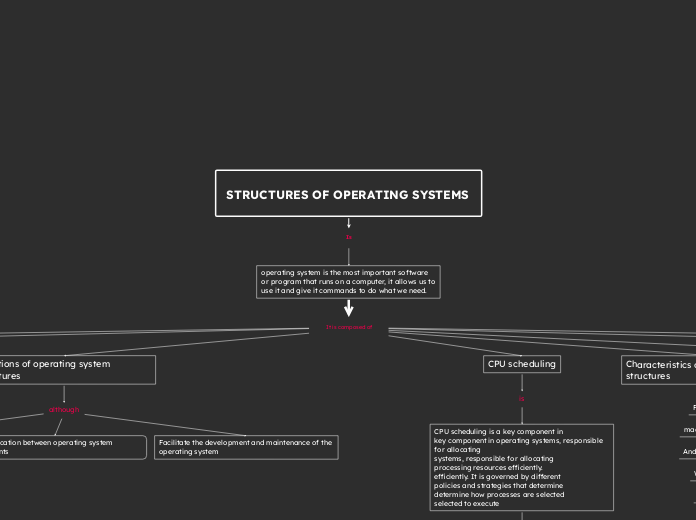STRUCTURES OF OPERATING SYSTEMS
Is
operating system is the most important software or program that runs on a computer, it allows us to use it and give it commands to do what we need.
Definition of operating system structures
next
Concept of structure in operating systems
Importance of structures in operating systems
Types of operating system structures
are
Monolithic structure
Advantages and disadvantages of the monolithic structure
Description of the monolithic structure
Layered structure
Description of the layered structure
Advantages and disadvantages of the layered structure
Client-server structure
Description of the client-server structure
Advantages and disadvantages of the client-server structure
Modular structure
Description of the modular structure
Advantages and disadvantages of the modular structure
Microkernel structure
Advantages and disadvantages of the microkernel structure
Functions of operating system structures
although
Organization and resource management
Communication between operating system components
Facilitate the development and maintenance of the operating system
CPU scheduling
is
CPU scheduling is a key component in
key component in operating systems, responsible for allocating
systems, responsible for allocating
processing resources efficiently.
efficiently. It is governed by different
policies and strategies that determine
determine how processes are selected
selected to execute
your information
Feedback Policy
Feedback policy dynamically adjusts the quantum of time based on past performance of the process. | | Provides balance between short and long processes
Policy Multinivel
The multilevel policy organizes processes in several queues with different priorities. Processes can move between queues based on their behavior.
based on their behavior.
priority policy
The priority policy assigns priorities to processes and
priorities to the processes and
runs those with the highest priority first.
priority first. It can be proportional
or non-proportional.
PolicyRound Robin
The Round Robin policy assigns a
quantum of time to each process
in a circular cycle. It is fair,
but can generate latency for short or long | | processes.
short or long processes.
Planning Policies
Planning policies
define the rules for selecting
which process will be executed and when.
Some of the most common policies are FIFO, SJF, Round Robin, Priority, Multilevel and Feedback,
Priority, Multilevel and Feedback.
SJF (Shortest Job First) Policy
The SJF policy selects the process with the shortest execution time. It can be non-preemptive or preemptive, depending on the situation.
the situation
FIFO Policy
(Frist In, Frist Out)
The FIFO policy follows the principle
that the first process to arrive
is the first to be executed.
It is simple but can generate
"convoy effect" and does not consider the duration of the processes.
Process Queues
Process queues are essential to organize and
to organize and manage waiting processes. These queues can be classified according to the associated scheduling policy, such as the queue associated planning policy, such as ready queue, waiting queue, among others. ready queue, waiting queue, among others.
Characteristics of operating system structures
FreeBSD (modular structure)
macOS (client-server structure)
Android (microkernel structure)
Windows (layered structure)
Linux (monolithic structure)
Examples of operating systems using different structures
Security
Performance
Flexibility
Scalability
Modularity
Mobile networks
so
A set of technologies that
enable wireless data and voice
wireless voice and data communication
between devices
next
Features
- Efficiency: Higher spectral efficiency, lower energy consumption
- Connectivity: Progressive improvement, increasing number of connected devices
- Capacity: Significant increase with each generation
- Latency: 1G (high), 2G (improvement), 3G (100-500 ms), 4G (less than 30 ms),5G (less than 1 ms).
- Speed: 1G (analog), 2G (up to 64 Kbps), 3G (several Mbps), 4G (up to 1 Gbps), 5G (several Gbps)
- Speed: 1G (analog), 2G (up to 64 Kbps), 3G (several Mbps), 4G (up to 1 Gbps), 5G (several Gbps)
Devices
- IoT devices: Internet of Things devices that connect to the network to exchange data and perform functions.
- Tablets: Portable devices with functionalities similar to smartphones, but with a larger screen.
- Smartphones: Mobile devices with processing capabilities
Infrastructure
- Data Centers: Store and process data for the mobile network.
- Towers: Structures for placing antennas at elevated heights
- Antennas: Transmitters/receivers for wireless communication
- Base Stations: Connection points for mobile devices
Technologies
- GSM: Sistema Global para Móviles
- CDMA: Code Division Multiple Access
- LTE: Long-Term Evolution
- WiMAX: Worldwide Interoperability for Microwave
- NR (5G): New Radio
Generations
- 1G: Analog (voice)
- 2G: Digital (SMS)
- 3G: Mobile data
- 4G: Broadband
- 5G: High speed and low latency
Network Operating Systems
thus
Common Characteristics
Centralized administration
Resource sharing (files, printers, etc.
User and permissions management
Network communication (protocols, services)
Main Functions
Coordination of Processes and Tasks
Security
Fault Management
Resource Management (CPU, Memory, Disk)
User Interface
Access to Shared Resources
Examples of Operating Systems
- Windows Server
- Linux Server
- Unix
- macOS Server
- Novell NetWare
- Windows, macOS, Linux (clients)
Types of Operating Systems|
Distributed Operating Systems
Client Operating Systems
Server Operating Systems
